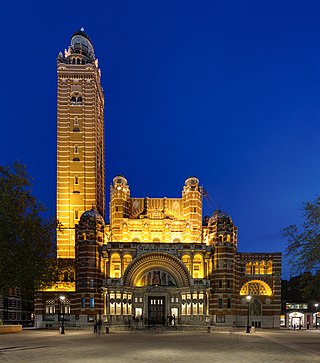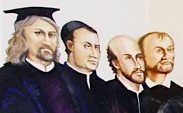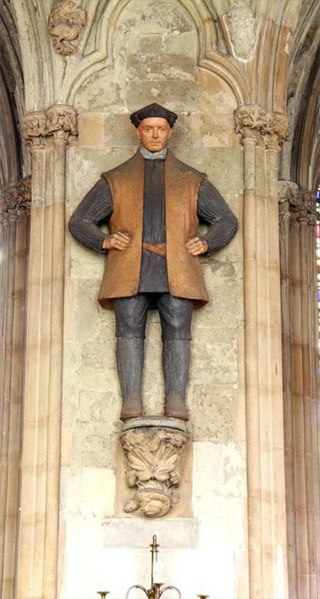
The Forty Martyrs of England and Wales or Cuthbert Mayne and Thirty-Nine Companion Martyrs are a group of Catholic, lay and religious, men and women, executed between 1535 and 1679 for treason and related offences under various laws enacted by Parliament during the English Reformation. The individuals listed range from Carthusian monks who in 1535 declined to accept Henry VIII's Act of Supremacy, to seminary priests who were caught up in the alleged Popish Plot against Charles II in 1679. Many were sentenced to death at show trials, or with no trial at all.
Bishop Douglass Catholic School is a Roman Catholic co-educational secondary school and sixth form, situated in East Finchley area of the London Borough of Barnet, England. Its current Headmaster is Martin Tissot, a former pupil at the school.
John Roberts, OSB was a Welsh Benedictine monk and priest, and was the first prior of St. Gregory's, Douai, France. Returning to England as a missionary priest during the period of recusancy, he was martyred at Tyburn. He is venerated as a saint by the Catholic church.
Mark Barkworth was a Catholic priest and martyr.
John Adams was an English Catholic priest and martyr.
John Lowe (1553–1586) was an English Catholic priest and martyr.

Roger Filcock was an English Jesuit priest. He was beatified as a Catholic martyr by Pope John Paul II on 22 November 1987.
John Almond was an English Catholic priest. He was ordained in 1598 and suffered martyrdom in 1612. Canonised in 1970, John Almond is one of the Forty Martyrs of England and Wales.

Nicholas Owen, S.J., was an English Jesuit lay brother who was the principal builder of priest holes during the reigns of Queen Elizabeth I and James I of England. Owen built many priest holes in the buildings of English Catholics from 1588 until his final arrest in 1606, when he was tortured to death by prison authorities in the Tower of London. Owen is honoured as a martyr by the Catholic Church and was canonized by Pope Paul VI in 1970.
Richard Leigh was an English Roman Catholic martyr born in Cambridge, the scion of Cheshire gentry, squires of the West Hall, High Legh since the 11th century.

The Catholic Church in the United Kingdom is part of the worldwide Catholic Church in communion with the Pope. While there is no ecclesiastical jurisdiction corresponding to the political union, this article refers to the Catholic Church's geographical representation in mainland Britain as well as Northern Ireland, ever since the establishment of the UK's predecessor Kingdom of Great Britain by the Union of the Crowns in 1707.

Anne Line was an English Catholic martyr. After losing her husband, she became very active in sheltering clandestine Catholic priests, which was illegal in the reign of Queen Elizabeth I. Finally arrested, she was condemned to death and executed at Tyburn. The Catholic Church declared her a martyr, and Pope Paul VI canonised her in 1970.

Irish Catholic Martyrs were 24 Irish men and women who have been beatified or canonized for dying for their Catholic faith between 1537 and 1681 in Ireland. The canonisation of Oliver Plunkett in 1975 brought an awareness of the others who died for the Catholic faith in the 16th and 17th centuries. On 22 September 1992 Pope John Paul II proclaimed a representative group from Ireland as martyrs and beatified them.

Eustace White was a Catholic priest. Due to his service, he was put on trial in December 1591 and subsequently hanged, drawn and quartered at Tyburn on 10 December 1591, along with another priest and three laymen. He is one of the Forty Martyrs of England and Wales and was canonised by Pope Paul VI in 1970.

John Roche was a Catholic martyr, born in Ireland, who died in London, England on 30 August 1588.
John Pibush was an English Catholic priest. He is a Catholic martyr, beatified in 1929.
Thomas Holford (1541–1588) was an English Protestant schoolteacher who became a Catholic priest during the reign of Queen Elizabeth I. He was martyred at Clerkenwell in London, and is recognised by the Catholic Church as having the status of Blessed.
Richard Martin was an English martyr. A layman, Martin was charged with being a "receiver and maintainer of priests" for having bought supper for Robert Morton, a priest.

Margaret Clitherow was an English saint and martyr of the Roman Catholic Church, known as "the Pearl of York". She was pressed to death for refusing to enter a plea to the charge of harbouring Catholic priests. She was canonised in 1970 by Pope Paul VI.









